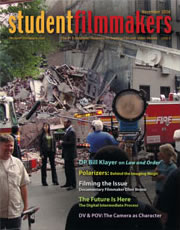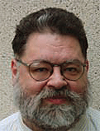HOW-TO, Techniques, & Best Practices Channel
| Filming the Issue: Documentary Filmmaker Ellen Bruno By Patrick Drazen posted Nov 2, 2008, 09:13 |
Check out this article in the print edition of StudentFilmmakers Magazine, November 2006. Click here to get a copy and to subscribe >>
 Filming
the Issue
Filming
the Issue
Documentary Filmmaker Ellen Bruno
by Patrick Drazen
�I grew up without a TV in the house,� laughs Ellen Bruno, a documentary filmmaker
who didn�t plan to make films. A native New Yorker, she now lives and works
in San Francisco, although her work has taken her around the globe to Tibet,
Cambodia, Thailand, and Mexico. �The game plan never was to forge ahead as a
filmmaker. I never had any intention of making films. I was really involved
in refugee relief work.� She was a political activist for eight years before
she made her first film, and she picked up a camera in part because �we were
frustrated by the lack of attention being brought to certain political events.�
Bruno sees her work as �using media as a lobbying tool and raising consciousness
among politicians.�
 �When
I was working with Quakers in New York, I got together with a friend and made
a funky little film about healthcare from a Cambodian perspective. And it got
to every country where Cambodians were being resettled,� following the disastrous
regime of Pol Pot and the Khmer Rouge war, in which one third of Cambodia�s
six million people were killed and thousands of others scattered as refugees
around the globe. That first film focused on how the Cambodian refugees put
more trust in native shamans and Buddhist priests than in western medicine.
�When
I was working with Quakers in New York, I got together with a friend and made
a funky little film about healthcare from a Cambodian perspective. And it got
to every country where Cambodians were being resettled,� following the disastrous
regime of Pol Pot and the Khmer Rouge war, in which one third of Cambodia�s
six million people were killed and thousands of others scattered as refugees
around the globe. That first film focused on how the Cambodian refugees put
more trust in native shamans and Buddhist priests than in western medicine.
 In
1989 Bruno decided to get serious about the technical side of filmmaking, and
began working on a Masters degree in documentary filmmaking at Stanford. The
classroom work took nine months; then came her thesis film, eventually titled
Samsara.
In
1989 Bruno decided to get serious about the technical side of filmmaking, and
began working on a Masters degree in documentary filmmaking at Stanford. The
classroom work took nine months; then came her thesis film, eventually titled
Samsara.
�The school was really taken aback (about her plans to film in Cambodia). I
managed to get a small grant, get a visa and get a small crew in. This was a
rare opportunity. I think I left before Stanford could say �no.�
�It was definitely initiation by fire. I ended up bringing Ellen Kuras, a friend
who was a still photographer. It was an incredibly stressful time. We weren�t
allowed to make our film, we were followed by government spies. I finished the
film and thought, �That�s it.��
 Then
came the editing, and Bruno�s real birth as a filmmaker. Her first cut �was
deadly boring. I tore it up and made a more personal thirty minutes about the
inner world of the Cambodian people. I was surrounded by 150,000 people still
fully functioning and mentally intact after the most terrible genocide. I began
to absorb, not consciously see, how Buddhism informed all of the decisions they
made.�
Then
came the editing, and Bruno�s real birth as a filmmaker. Her first cut �was
deadly boring. I tore it up and made a more personal thirty minutes about the
inner world of the Cambodian people. I was surrounded by 150,000 people still
fully functioning and mentally intact after the most terrible genocide. I began
to absorb, not consciously see, how Buddhism informed all of the decisions they
made.�
Samsara is an impression rather than a documentary, shifting from narrative
to description to evocation. �It was a nontraditional structure influenced by
the people around me, how they lived their lives. Not just Buddhism, but the
life of the spirit�how do we make choices, putting our suffering and joy in
some sort of context. How do you talk politics to a farmer in Cambodia? His
concern is, �how many bags of rice can I harvest? My kid is sick.� People needed
a new, personal way to absorb information.
�I got flak from the Stanford professors, but the ball kept rolling. Certain
people will definitely resist or dismiss; that�s predictable. There�s plenty
of people doing the other kind of work. The support and opportunities were always
there for me.�
Her Cambodian experience led directly to her next documentary: Satya: A Prayer
for the Enemy, focusing on Tibetan Buddhist nuns coping with Chinese oppression.
�I made a conscious choice to do a Tibetan film.� The experience helped Bruno�s
understanding of Buddhism, which in turn refined her style of filmmaking.
�The Buddhists say, �Kill your mind.� People process so much information in
their heads; if people have a more visceral response, their reactions would
be much greater. If I can make a film for someone who�s not politically aware,
they can say, �Okay, I�m a mother, that woman is a mother.� To reduce it to
the most common denominator, the heart rather than the head.�
Despite success as a documentary filmmaker (Samsara has received, among
other honors, the Edward R. Murrow Award, a Special Jury Award at the Sundance
Film Festival, and a Student Academy Award from the Academy of Motion Picture
Arts and Sciences), Bruno, a mother of two, is still trying to accept it all.
�It still hasn�t sunk in, that this is my path. What serves me best? What serves
the issue best?�
This article may not be reprinted in print or internet publications
without express permission of StudentFilmmakers.com. Photos may not be copied
or reproduced.
Check out this article in the November 2006 print edition of StudentFilmmakers magazine, page 20. Click here to get a copy of the November 2006 Edition, so you can read and enjoy all of the excellent articles inside.
About the Author:
 Patrick Drazen is a freelance writer and author of "Anime Explosion:
The What? Why? And Wow! Of Japanese Animation".
Patrick Drazen is a freelance writer and author of "Anime Explosion:
The What? Why? And Wow! Of Japanese Animation".
Resources:
About StudentFilmmakers Magazine & StudentFilmmakers.com >>
Join the Film and Digital Networking Community >>
Post Your Films, Videos, Reels, and Trailers >>
Discuss Motion Picture Techniques in the Online Industry Forums >>
Get the StudentFilmmakers.com E-Newsletter >>
StudentFilmmakers magazine would like to hear from you!
Click here to
share your comments and feedback about the magazine, monthly editions, your
favorite articles, and your favorite topics.
We always welcome and appreciate your Reader Comments. View them here, and send yours to the editorial team today!